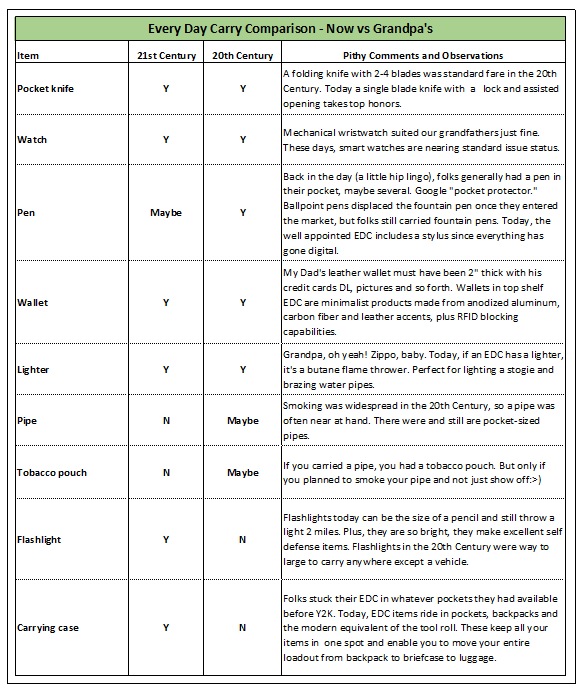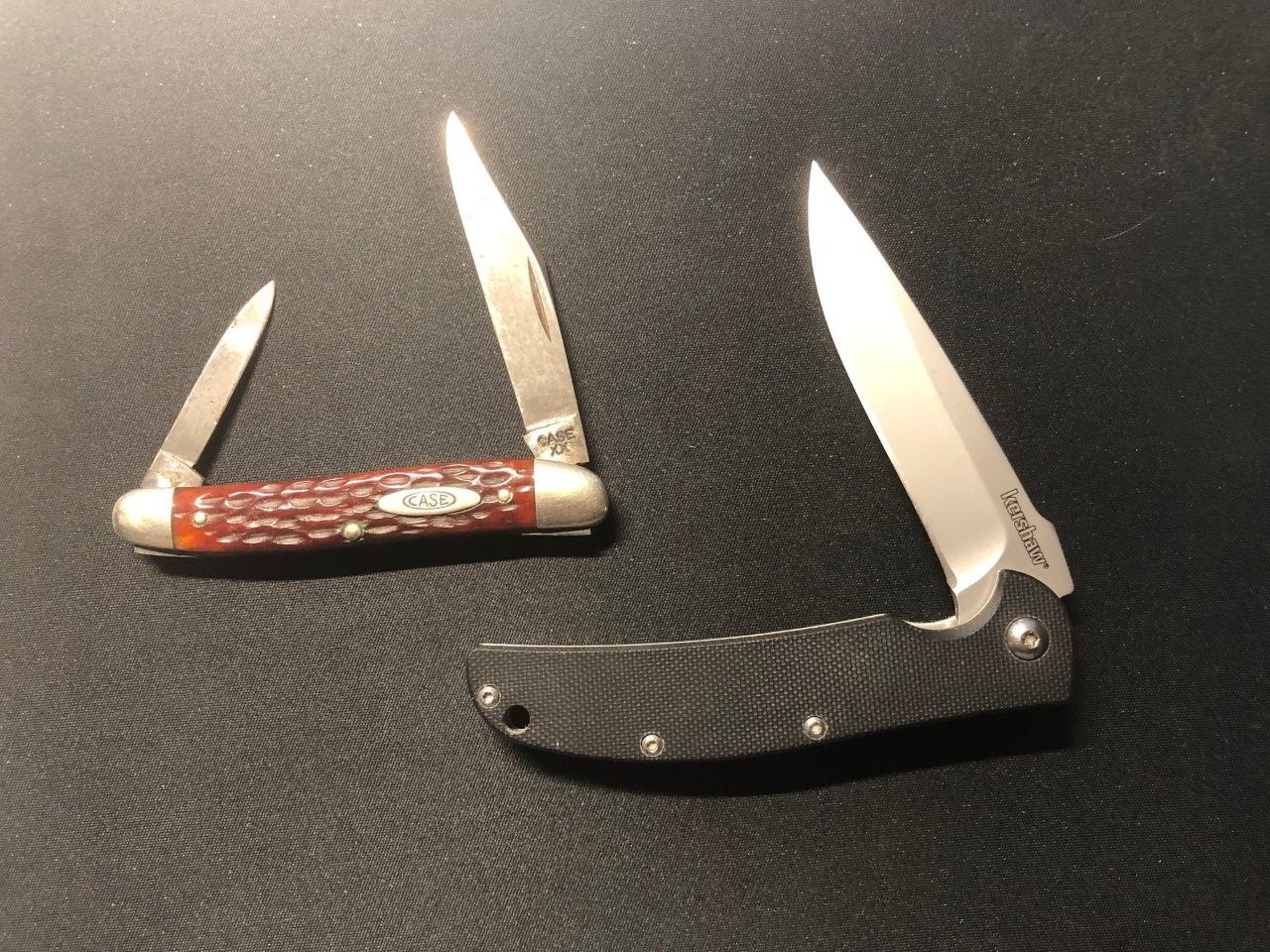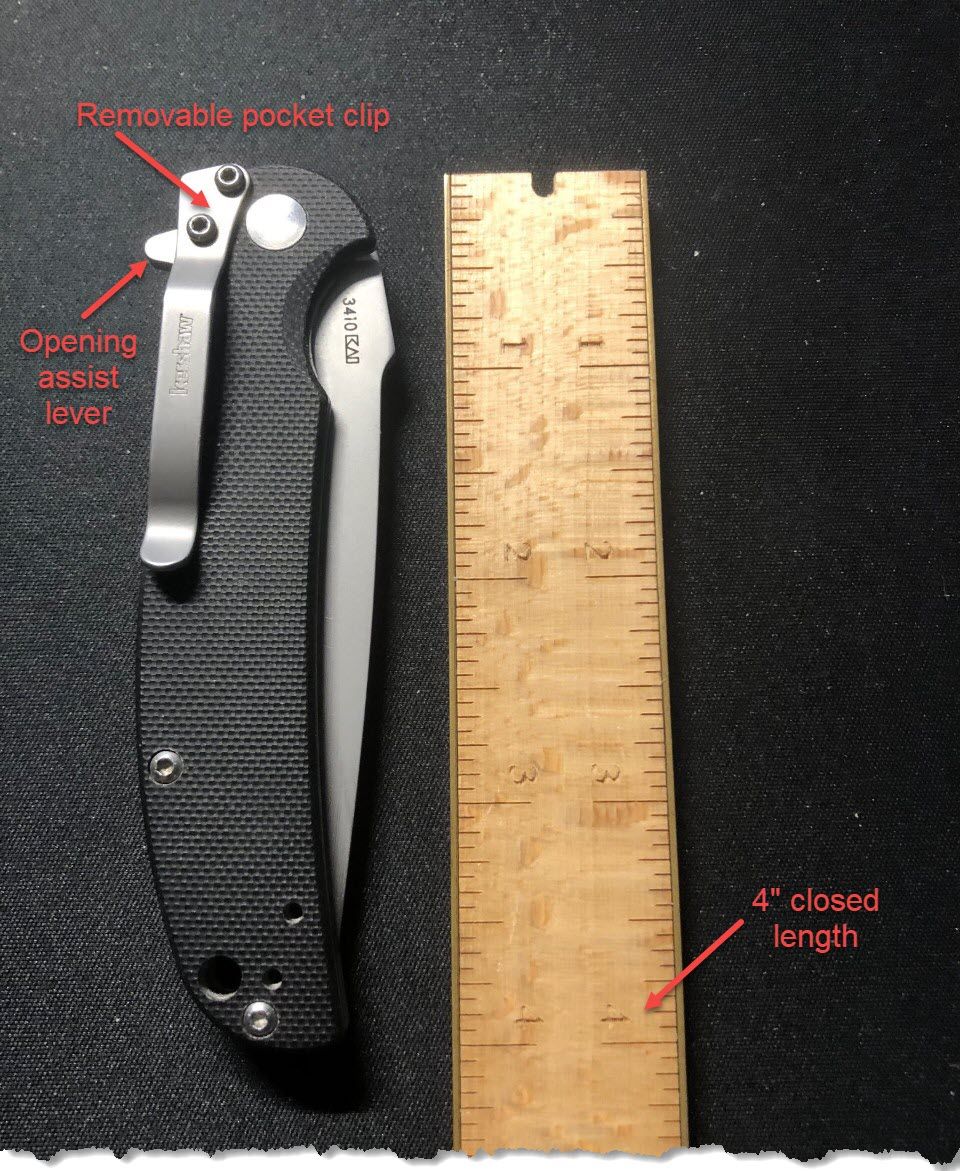How to Select Your First Everyday Carry (EDC) Knife
The humble pocketknife is one of the most useful things you can carry with you every day. Read on to learn how to select your first everyday carry (EDC) knife.

Everyday Carry - new name, old practice
You've likely seen the term "Everyday carry (EDC)" as you've surfed the web. In days past, people carried useful and necessary items with them daily. It wasn't until the 21st Century that daily carry became known by its EDC moniker. I'll have to admit it simplifies the practice's description.
So, how does the modern EDC compare with our grandfathers' load out? A simple table should help here.

The history lesson is over! Let's take a look at some fun EDC knife stuff.
A really brief look at knife styles
Knife makers are no slouches when it comes to offering a massive range of pocketknife styles or form factors if you prefer. I won't bore you with the entire list; instead, I will enumerate a few more common ones.
- Congress
- Canoe
- Peanut
- Trapper
- Barlow
- Sodbuster
- Copper Lock
- Jack
- RussLock
- Linerlock
- Folder
With all these styles of pocketknives available, which one makes the best EDC choice? Well, like anything, the choice depends on what you want to do with it. Also, remember, like cameras, the best knife to have is the one you have with you.
What's the best knife for EDC?
With all these styles of pocketknives available, which one makes the best EDC choice? Well, like anything, the choice depends on what you want to do with it. Also, remember, like cameras, the best knife to have is the one you have with you.
Choosing your EDC pocketknife
My Dad and I collected pocketknives and inherited his collection in 2020. Now I have enough options to carry a different knife a week and a bit more. I choose some for sentimental reasons and others for more practical ones.
Saying that I usually carry a single-blade folder with either a spring or liner lock. The ones I prefer have thumb studs or a fixed opening assist feature. I love that I can open and close these knives with one hand, which is mighty convenient. Other times, I carry a regular pocketknife with 1 - 3 blades. Check out examples of each style from my collection.

What countries make the best knives?
There are several countries renowned for their knives. They include America, Germany, Spain, Italy and China. You can buy quality knives from any country, but these five are, in my opinion, the best.
If I sensed an eyeroll over mentioning China, let me explain why they made my list. American knifemakers traveled to China several decades ago to procure lower-cost knives. However, unlike other industries, these companies taught the Chinese how to make high-quality pocket and different types of knives. As a result, you can buy a Chinese knife in the Rough Rider line for around $10. The workmanship, fit and finish, and quality of materials are fantastic. My Dad and I added several of these to our collections.
Handy uses for an EDC pocketknife
How do I use my pocketknife?
It never ceases to amaze me what I can do with my knife. Opening boxes and envelopes top the list. Trimming threads and cutting a label out of clothing that bugs me comes in a strong second. Opening safety seals on food and pill items happens regularly. Cutting the foil from a wine bottle goes better with a sharp knife in your pocket. Peeling fruit like oranges and apples makes up another activity. Finally, whittling is hard to beat if you're bored and happen to have a nice, sturdy stick at hand.
Aside from these mundane uses, I've had a few unusual cases where my pocketknife came in mighty handy. Here's one that I recall vividly, several decades later. Driving home from work one snowy winter evening, I stopped at a traffic light only to have the fellow behind me stop using my car as an additional braking mechanism. I hopped out to inspect the damage.
Unfortunately, my car had a habit of locking the doors itself. Seeing no damage, I discovered my trusty steed had locked the doors for me, leaving me partway into a snowy intersection, at night, during rush hour. "Open the door HAL. I'm sorry, Dave. I can't do that."
Coat hangers wouldn't work, and even if I had a slim jim, it'd be in the trunk. So, using my pocketknife with a 1.5" long blade, I cut out a rear fixed window, reached in and opened my door. The knife enabled me to get out of traffic and saved having to break the window to get inside. The lesson learned is even a small knife can be of service.
EDC knife etiquette and tips
Before carrying a pocketknife daily, you need to understand the proper etiquette of knife use outside your home.
- Please treat it with respect, and don't use it for any purpose other than cutting. For example, never use your knife to pry open a paint can.
- Observe applicable laws and regulations about where your knife is unwelcome. You know, like flying, entering any governmental building, patronizing businesses that tell you to leave your blades at home and so on. For example, don't show up for jury duty with even the least harmful-looking cutting device. They will confiscate it!
- Do not show off your EDC knife in the presence of "sensitive types" who are easily triggered, as they may need to run for a safe space. And rat you out to whoever will listen.
- Do not trim the dirt from under your fingernails while in public. I mean, gross! Believe it or not, this bit of etiquette came from none other than General Stonewall Jackson. Pretty cool!
- Unless you have a "gentleman's" steak knife, don't cut your food with your pocketknife while dining out. I plan to add one of these knives to my collection eventually!
- Keep your knife blades clean and remove pocket lint from inside the body.
There, that's not so bad, is it?
What do I recommend?
My recommendation for an excellent, all-purpose EDC knife is the machete. Oops, wrong post! The machete should be your EDC for camping and brush clearing. No, I recommend a single-blade folder with an opening assist and blade-locking feature. Here are the specifications:
- Handle material: G10 or comparable synthetic
- Closed length: 4"
- Blade length: 3.5"
- Blade material: Stainless steel
- Opening assist: Thumb stud or integral lever
- Locking mechanism: Linerlock or backspring
Pocket clips
Knives like this often come with a pocket clip that allows you to secure it at the top of your pocket versus carrying it inside your pocket. I see this as a matter of personal preference, and my practice is to remove and save the pocket clip.
The Kershaw I showed in an earlier photo fulfills all the specifications and has a pocket clip I haven't removed. You can see the clip details below.

Great places to purchase your EDC knife or knives
Smoky Mountain Knife Works (SMKW) tops my list of places to buy your EDC. They proclaim themselves the largest knife store in the world, and I am inclined to agree with them. Driving the five (5) hours to SMKW in Sevierville, TN, every Black Friday was a Tate family tradition, and man is that place a sight to behold!
Atlanta Cutlery comes in next. While not nearly as big as SMKW, they have a terrific selection of quality knives of every shape and size.
Check out Museum Replicas, Atlanta Cutlery's sister store, if you're a-hankering for an affordable, quality sword as your EDC.
Us Southern boys know our steel as evidenced by these fine establishments. I'll add another for your consideration that has a twist, Cutlery Corner. The folks carry many of the same brands as SMKW, and their prices are as good.
Now, here's the twist, you can watch them on television. They are the knife version of the Home Shopping Network. They are fun to watch. My Dad and I would tune them in regularly when I visited.
The second part of their twist is their package deals. They sell up to 100 knives as dealer stock, priced to where some knives are less than $1.00. I've purchased a much smaller set, and while the quality isn't the best, these are rugged, useful blades for dumbfoundingly low prices.
You can buy pocketknives nearly anywhere, from hardware stores to upscale outfitters like Orvis, Eddie Bauer, Filson and L. L. Bean. Their offerings are always outstanding but come with an "outstanding" price to match. I've never purchased a knife from any of these stores because I can get equal or better quality for a lot less elsewhere.
Final thoughts - my preferred brands
It's getting late, and I need to conclude this blog post. Folks often ask me which knife companies or brands I like and would recommend to them. So, here goes.
- Boker - Germany
- Gerber - United States
- Columbia River Knife and Tool - United States
- Buck - United States
- Hen & Rooster - Germany
- Kershaw - United States
- Marbles - China
- Rough Ryder - China
- Case - United States
- Puma - Germany
- Spyderco - China
- Eye Brand - Germany
- Swiss Army - Switzerland
- Bear and Son - United States
I have used knives from each of these brands and can recommend them unequivocally as of the writing of this post. You know, things can change.
Epilogue: With proper care, your EDC pocketknife will last for generations
Pocketknives, and knives generally, are made to last. With proper care and use, they can be handed for generations. As a case in point, the Case pocketknife I picture in this article belonged to my Dad's father, who, in turn, gave it to me many years ago. I still have nearly every knife I've ever owned, and they are all in excellent condition, aside from a nick or ding here and there.
To keep your pocketknives in prime condition, follow these simple steps:
- Clean the blades regularly to remove dirt, oil, tape residue from opening boxes, and so forth. I recommend WD 40 for this purpose.
- Remove pocket lint and other debris occasionally. Toothpicks and a strong breath will do the job nicely.
- Lightly oil the pivot points of the knife once in a while. WD 40 works, as do dry Teflon oils like those used on bicycle chains. The objective is to keep the blades operating smoothly without leaving a stain on your pants.
- Remove rust from carbon steel blades. Today's two most common blade materials are high-carbon tool steel (it will rust and darken with use) and stainless steel. I use two methods to remove rust from my carbon steel blades, WD 40 with fine steel wool or Simichrome Paste with a rag. The advantage of WD 40 is it lubricates as it cleans. The advantage of Simichrome is that you can clean anything metal, including brass, silver, copper, etc.
